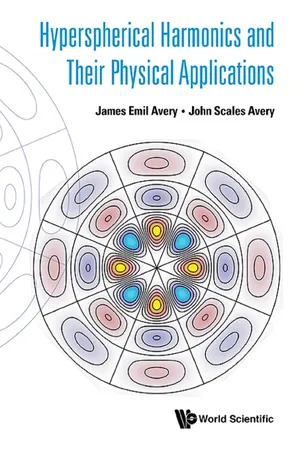Physics
Lagrangian Density
The Lagrangian density is a mathematical function used in physics to describe the dynamics of a system. It is defined as the difference between the kinetic and potential energy of a system, and is used to derive the equations of motion for the system. The Lagrangian density is a fundamental concept in classical mechanics and quantum field theory.
Written by Perlego with AI-assistance
Related key terms
Related key terms
1 of 4
Related key terms
1 of 3
3 Key excerpts on "Lagrangian Density"
- James Emil Avery, John Scales Avery;;;(Authors)
- 2017(Publication Date)
- WSPC(Publisher)
z, and later we will generalize to spaces of higher dimension and also to spaces where the metric is non-Euclidean. We have just been discussing normal modes for small vibrations of a classical system of particles about the equilibrium positions. We might also wish to discuss the normal modes of a violin string or a drumhead, or the harmonics of sound waves inside a closed container. In these examples, the medium can be regarded as continuous as long as we are considering low frequencies, but at high frequencies, where the wavelength is comparable to the distance between the particles of which the system is composed, this picture breaks down. But at low frequencies, the displacement from equilibrium can be treated as a field.There are other fields that one might wish to consider, such as electromagnetic fields. What we now wish to discuss is the problem of how to start with a wave equation in classical mechanics, and how to pass over to a quantum mechanical treatment of the system. In order to do this, it is useful to introduce the concept of a Lagrangian Density, This is sometimes defined as the kinetic energy per unit volume of space, minus the density of potential energy. However, in some cases, for example when the Lagrangian must be invariant under a Lorentz transformation, this definition cannot be used, and we must instead define the Lagrangian Density as that which gives the correct wave equations. The usual Lagrangian of the system is the Lagrangian Density integrated over the whole volume of the system.The variational principle from which the equations of motion can be derived can be written in the formSuppose that the continuous system is described by a number of fields, ϕ1 , ϕ2 , … , ϕIf we change one of the fields by a small amount, the resulting change in the Lagrangian Density is given by The variational principle then becomesn, which are continuous functions of the space and time coordinates x, y, z and t. For example, ϕ1 , ϕ2 , … might represent the components of the electromagnetic field. Suppose also that the Lagrangian Density can be expressed in terms of the fields and their first derivatives with respect to the space and time coordinates, so thatThe second term on the right-hand side of (10.77) can be integrated by parts in a manner analogous to equations (10.11) –(10.14) . Thus, for example, we can writeThe first term to the right of the = sign is required to vanish because the variation must be zero at the end points. In this way, we can rewrite the variational principle (10.74)- eBook - ePub
- David Griffiths(Author)
- 2020(Publication Date)
- Wiley-VCH(Publisher)
A field, on the other hand, occupies some region of space; in field theory our concern is to calculate one or more functions of position and time : ϕ i (x, y, z, t). The field variables ϕ i might be, for example, the temperature at each point in a room, or the electric potential V, or the three components of the magnetic field B. In particle mechanics, we introduced a Lagrangian L that was a function of the coordinates, q i, and their time derivatives, ; in field theory we start with a Lagrangian (technically, a Lagrangian Density) ℒ, which is a function of the fields ϕ i and their x, y, z, and t derivatives: (10.9) In the former case, the left side of the Euler–Lagrange Equation 10.6 involves only the time derivative; a relativistic theory must treat space and time coordinates on an equal footing, and the Euler–Lagrange equations generalize in the simplest possible way, to: (10.10) Example 10.1 The Klein–Gordon Lagrangian for a Scalar (Spin-0) Field Suppose we have a single, scalar field variable ϕ, and the Lagrangian is (10.11) In this case, (10.12) (If this confuses you, write out the Lagrangian ‘longhand’: In this form, it is clear that and so on.) Meanwhile and hence the Euler–Lagrange formula leads to (10.13) which is the Klein–Gordon equation (Equation 7.9), describing (in quantum field. theory) a particle of spin 0 and mass m. Example 10.2 The Dirac Lagrangian for a Spinor () Field Consider now a 2 spinor field ψ, and the Lagrangian (10.14) We treat ψ and the adjoint spinor as independent field variables. * Applying the Euler–Lagrange equation to, I find so that (10.15) This is the Dirac equation (Equation 7.20), describing (in quantum field theory) a particle of spin and mass m - eBook - ePub
The Common Extremalities in Biology and Physics
Maximum Energy Dissipation Principle in Chemistry, Biology, Physics and Evolution
- Adam Moroz(Author)
- 2011(Publication Date)
- Elsevier(Publisher)
[6] . It was also briefly discussed that for electromagnetic and spinor fields, there are internal, more sophisticated (not just modeled by complex conjugation) degrees of freedom of internal spaces, under the small transformations in which the formal Lagrangian form does not change. A similar symmetry of that or other Lagrangians of the fields relative to transformations of some set of internal spaces materialized in the characteristics of real particles simulated by the mentioned fields. This forms the essence of the modern formal description of physical interactions: electromagnetic, nuclear, weak, and even gravitational.Moreover, it turns out that on the basis of the principle of symmetry, one can not only conduct the distinctions of various physical interactions but also formally unite them in a certain hierarchy, according to the internal degrees of freedom. This can be done on the basis of the type of Lagrangian symmetry, in other words, from the perspective of the penalty used in this study, on the basis of the local symmetry of the penalty relative to some transformations in internal spaces.It is interesting to note, when comparing transformations of fields to biologically organised forms of dissipative phenomena, the penalty interpretation of the invariability of Lagrangian. In this sense one need to illustrate to what extent this invariability of the Lagrangian in the transformations of internal spaces predetermines the aspects of the dynamic characteristics of interactions and how its penalty interpretation would look.As it was illustrated above, the Lagrange function in mechanics or the Lagrangian in the field theory can be interpreted by an analogy with biokinetics as the instant penalty for the difference of the real state from an optimal one. The Lagrangian in the field theory expresses the local penalty for the deviation of both the amplitudes of fields from the optimum and zero-value kinetic amplitudes, expressed by the kinetic part. Thus, also the breaking in the Lagrangian symmetry under some transformation of fields, or their phases, could be an approach for interpreting the symmetry of the Lagrangian as a local penalty measure. On this basis, the interactions could be represented as locally compensating the penalty (or energetic cost).It may be reasonable to illustrate and follow the technical aspects/backgrounds of the formalism of the symmetry method in the field theory. It is known that the invariance of the Lagrangian under the transformations of the type
Index pages curate the most relevant extracts from our library of academic textbooks. They’ve been created using an in-house natural language model (NLM), each adding context and meaning to key research topics.
Explore more topic indexes
Explore more topic indexes
1 of 6
Explore more topic indexes
1 of 4


